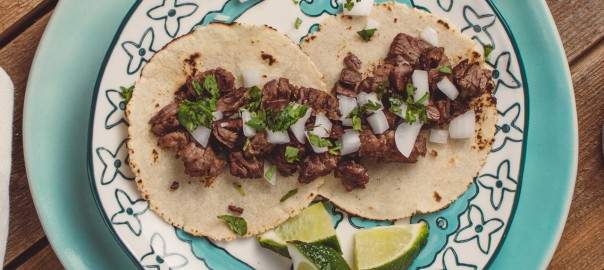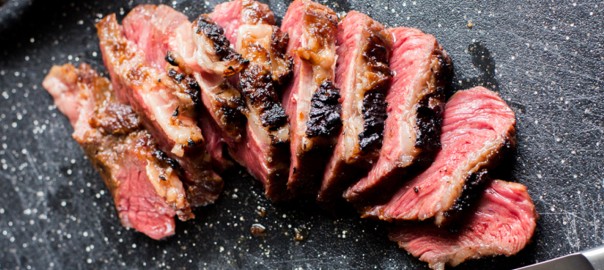Nothing is better than taking some delicious meats, tossing them in some marinades or throwing a bit of rub on them, chucking them on the grill, and then cutting them up, and wrapping them in a few soft tacos with some pico de gallo or cilantro and onion.
Steak tacos, pork tacos, chicken tacos. All great. All quick and easy to make.
But there is so much more to Latin American cuisine than tacos; this is especially true if you combine the rich, sweet, and savory flavors with healthy grass-fed beef, heritage-breed pork, and free-range chicken.
With Cinco de Mayo coming up this weekend, we wanted to break down some of our favorite dishes inspired by Latin American and Hispanic cultures. And while there are a lot of amazing, flavorful dishes to choose from, these are the standout Mexican and Latin American cooking styles and marinades.
Carne asada
If you want to make steak tacos the right way, you need some vital components. Of course, you need some fresh tortillas and some fresh salsa or pico de gallo — the difference between the two is that salsa is more like a soup or sauce, while pico de gallo is chopped tomato, onion, cilantro, and jalapeño. You might also want to add a bit of cojita or other cheese, guacamole, and some crema fresca or sour cream.
But meat is THE essential ingredient that defines a standard taco from a great taco.
While Americanized — or Tex-Mex tacos — like the ones you can find at Taco Bell can be a good quick treat, they do a severe injustice to the original: The street taco prevalent throughout Central and South America and the Caribbean.
Tacos using ground beef can be quite good. In particular, we prefer using grass-fed, grass-finished ground beef for our quick, homemade tacos. But nothing compares to a taco filled with a steak — seasoned and then seared on a grill or over hot charcoals — from the sirloin, tenderloin, or rib primals of a cow.
And, for the most part, that is what carne asada is. The Spanish word, “asada,” basically means grilled, and “carne” is an all-encompassing term for meat — even though carne asada is most often associated with beef. Carne asada is any Latin American-style steak. Kind of.
Carne asada is a steak preparation method most often associated with Mexico and some Central American countries. (Different Central and South American nations have other steak traditions that we’ll discuss below.)
Carne asada can be made from a wide variety of beef cuts. As a standalone steak, you can make carne asada from a ribeye. However, because it is often marinated, sliced, and served with pico de gallo, beans, and other rich dishes, carne asada is best with tougher cuts that benefit from marinating, such as flank steak, hanger steak, short ribs, sirloin tips, or skirt steak.
As for marinades, the typical carne asada marinade or sauce is usually some combination of salt, freshly-ground pepper, garlic, lime juice, cilantro, cumin, and chiles, like ancho chile or chipotle.
But the key to a delicious carne asada steak is an open fire or red-hot coals to grill over. Give the steak a little char, cut it up (against the grain if its a flank or skirt steak), and enjoy.
Across South America and Mexico, there is a range of different styles and processes to cook beef. Barbacoa, which originated in the Caribbean and gives us the word “barbecue” is a common way to cook beef over an open fire. Other methods are also well-known that derive from South America, including steak churrasco, which is a Brazilian-style of steak cooked rotisserie style (usually over an open flame) on a skewer or large knife.
We haven’t even delved into chimichurri sauce, which is one of the best steak marinades/sauces there is. But that’s a topic worthy of its own, lengthier breakdown. Most commonly used in Argentina, chimichurri accompanies steaks cooked in the Argentine manner — that is, they never touch a flame and are grilled over burning wood.
Al pastor versus carnitas?
Pork is often a featured dish in the cuisines of many Latin American cultures. Braised, slow-cooked, fire-roasted, or barbecued, there are many different ways that pork can be prepared for tacos, tortas, burritos, or even as the main dish in a variety of meals.
However, two of the best-known versions of pork made in Latin American countries are carnitas and al pastor, which, while cooked similarly, have quite different flavors.
Carnitas is a Mexican method of braising and then quickly roasting a large piece of pork shoulder, like a pork butt or Boston butt. Traditionally, a large portion of pork is placed in a copper pot and an array of spices — cumin, garlic, oregano, and chiles — are added along with lard or some other flavorful fat. After slow cooking for hours, the pork is then roasted on high heat, crisping the outer edge of the pork so that it is fall-apart tender.
Carnitas can be cooked in a Dutch oven or slow cooker, and you can experiment with a variety of different flavors, spice rubs, or marinades. However, a key step in the process of perfectly fork-tender carnitas is the finishing. While the best way to finish carnitas is by roasting, you can also quickly pan fry it so that it is both crispy and but maintains that fall-apart tenderness like pulled pork.
Al pastor is one of those fascinating international dishes that is the result of two culinary cultures mixing. Influenced heavily by the shawarma-style of spit roasting popular in the Mediterranean and the Middle East, al pastor is a combination of Mexican pork preparation reimagined by Lebanese immigrants who moved to Latin America in the twentieth century.
While spit roasting the pork shawarma-style has traditionally been the distinguishing mark of al pastor, these days, it is a unique sauce style that distinguished al pastor from carnitas for most Mexican food connoisseurs. Unlike most other taco, torta, or burrito styles, al pastor features a salsa that includes pineapple in addition to onion and cilantro.
If you get a pork dish at a Latin-American restaurant and it is heavy on pineapple flavor, you are likely eating al pastor.
Adobo and mole chicken
For quesadillas, fajitas, burritos, and tacos that feature chicken, there are endless preparation methods and flavorful marinades that can be used to give it the traditional spicy kick associated with Latin American food. But two of our favorites are chicken cooked in adobo sauce and mole chicken.
Chicken cooked in adobo sauce is usually quite spicy. Adobo sauces feature any combination of dried, roasted, and finely chopped ancho, chipotle, guajillo, and chile de árbol. The spicy concoction is often used to marinate chicken before being grilled, or it is added later to kick up the flavor of a dish.
Mole is a dark sauce that is both sweet and spicy. The spice comes from its heavy dose of hot chiles, including mulato, guajillo, ancho, and pasilla negro chiles. A more challenging to find chile, the chilhuacle rojo can also be used if you can get your hands on it.
The sweetness — and mole’s dark coloring — comes from the inclusion of chocolate and cinnamon in the sauce. In addition to cocoa and cinnamon, cumin, black pepper, tomatoes, onions, and a number of other spices can be added to a mole sauce.
The mole most common found in the United States is actually “mole poblano,” a sauce that originates in Mexico. (Where exactly is often disputed as both Oaxaca and Pueblo claim it originated there.) However, the sauce is popular in other areas of Central and South America; often, the chiles and other spices differ, giving it a unique flavor, texture, and color in each different locale it is made.
Traditional Mexican mole sauce is often used with turkey, but it is far more common to find mole chicken, which is the dark sauce either poured over boiled or grilled chicken or chicken that has been cooked and finished by simmering in mole sauce.
For more on some of our favorite Latin American dishes, check out the ButcherBox recipe page or some of Chef Yankel’s favorite cooking methods on YouTube.





